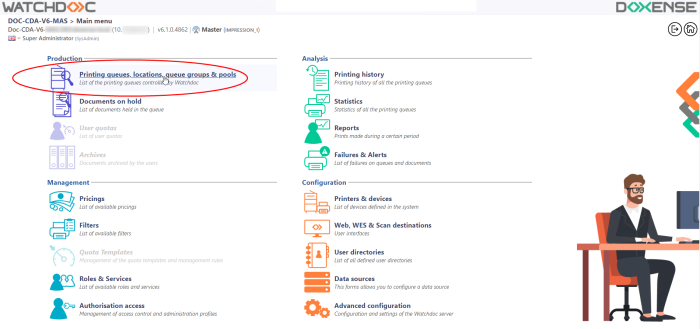Epson WES - Configure the WES onto the queue
Access the interface
-
From the Main Menu of the Watchdoc administration interface, in the Production section, click Print Queues, Queue Groups & Pools:

→ This takes you to the print queues interface. In this queue, activate the Controlled filter, then select the queue you want to configure:
-
For this queue, click the Edit Queue Properties button
 at the end of the line.
at the end of the line.
èYou are taken to the Print Queue Properties interface in which several sections are displayed. WES properties are managed in the WES section.
Configure the print queue mode
In the Print Queue Properties interface, General Information section, select the operating mode for the queue:
-
Mode: select Validation to have users validate queued jobs so that they are actually printed. If the queue belongs to a group configured in Validation mode, you can also select Like Group.
Configure the WES onto the queue
In the Print Queue Properties interface, click on WES to access the dedicated section.
-
Device - Activate embedded interface: tick the box to use a WES.
-
Profile subsection: From the list, select the WES to configure. The list comprises profiles created ahead of time in your instance of Watchdoc. If the desired profile is not found there, you will need to configure it (see Configure a WES article).
-
WES identifier subsection: Once you have ticked the box and selected the profile, the ID of the WES field will fill itself with “$AUTOSERIAL$”. Keep it that way so that the server will determine itself the serial number of the device and use it as the WES ID. You can also input directly the serial number of the device in this field.
-
Diagnosis subsection: It may be useful to activate WES trace logging, especially to diagnose an anomaly. Use this subsection to specify settings relating to WES trace log files:
-
Log level:From the list, select the type of requests you wish to trace:
-
Auto: retains standard traces;
-
Include binary content: retains detailed traces.

-
-
Configure the spools transformation
-
Transformation : specify with this parameter whether or not the spool transform is enabled on the queue and specify its characteristics:
-
Use group value: by default, if the print queue belongs to a print queue's group, it's the parameter set for the group that applies on the print queue;
-
Enabled: choose this setting to activate the spool transformation from this print-queue;
-
Disabled: choose this setting to disable the spools transformation from this print queue.
-
-
Diagnostics: Tick the box if you would like the spools to be retained and set the trace conditions:
-
Level: From the list, select the trace level that you wish to retain (none, errors, edited spools and all);
-
Enable for: From the, select the duration for activating spool tracing (one hour, one day, one week or one month):

-
Validate the configuration
1. Click on  to validate the WES configuration on the print queue.
to validate the WES configuration on the print queue.
2. After having configured the WES onto the queue, you must install it.